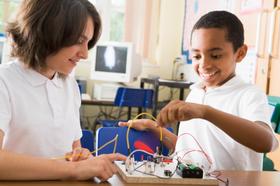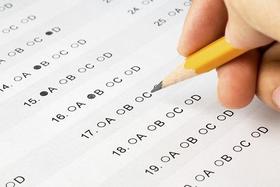Serving 1,257 students in grades 6-8, Campbell Middle School ranks in the top 50% of all schools in Georgia for overall test scores (math proficiency is bottom 50%, and reading proficiency is bottom 50%).
The percentage of students achieving proficiency in math is 31% (which is lower than the Georgia state average of 37%). The percentage of students achieving proficiency in reading/language arts is 40% (which is equal to the Georgia state average of 40%).
The student:teacher ratio of 17:1 is higher than the Georgia state level of 14:1.
Minority enrollment is 85% of the student body (majority Black), which is higher than the Georgia state average of 65% (majority Black).
Quick Stats (2025)
- Grades: 6-8
- Enrollment: 1,257 students
- Student:Teacher Ratio: 17:1
- Minority Enrollment: 85%
- Overall Testing Rank: Top 50% in GA
- Math Proficiency: 31% (Btm 50%)
- Reading Proficiency: 40% (Top 50%)
- Science Proficiency: 35% (Top 50%)
- Source: National Center for Education Statistics (NCES), GA Dept. of Education
School Overview
Campbell Middle School's student population of 1,257 students has declined by 20% over five school years.
The teacher population of 76 teachers has declined by 15% over five school years.
Grades Offered
Grades 6-8
Total Students
1,257 students

Gender %

Total Classroom Teachers
76 teachers

Students by Grade

School Calendar
School Rankings
Campbell Middle School ranks within the top 50% of all 2,204 schools in Georgia (based off of combined math and reading proficiency testing data).
The diversity score of Campbell Middle School is 0.63, which is less than the diversity score at state average of 0.71. The school's diversity has stayed relatively flat over five school years.
Overall Testing Rank
#1017 out of 2204 schools
(Top 50%)
(Top 50%)

Math Test Scores (% Proficient)
31%
37%

Reading/Language Arts Test Scores (% Proficient)
40%
40%

Science Test Scores (% Proficient)
35%
40%

Student : Teacher Ratio
17:1
14:1

American Indian
n/a
n/a
Asian
5%
5%

Hispanic
21%
19%

Black
55%
36%

White
15%
35%

Hawaiian
n/a
n/a
Two or more races
4%
5%

All Ethnic Groups



Participates in the National School Lunch Program (NSLP)
Yes
Eligible for Free Lunch
53%
59%

Eligible for Reduced Lunch
8%
5%

School Statewide Testing
School District Name
Source: National Center for Education Statistics (NCES), GA Dept. of Education
Profile last updated: 02/09/2025
Frequently Asked Questions
What is Campbell Middle School's ranking?
Campbell Middle School is ranked #1017 out of 2,204 schools, which ranks it among the top 50% of public schools in Georgia.
What schools are Campbell Middle School often compared to?
Campbell Middle Schoolis often viewed alongside schools like Griffin Middle School by visitors of our site.
What percent of students have achieved state testing proficiency in math and reading?
31% of students have achieved math proficiency (compared to the 37% GA state average), while 40% of students have achieved reading proficiency (compared to the 40% GA state average).
How many students attend Campbell Middle School?
1,257 students attend Campbell Middle School.
What is the racial composition of the student body?
55% of Campbell Middle School students are Black, 21% of students are Hispanic, 15% of students are White, 5% of students are Asian, and 4% of students are Two or more races.
What is the student:teacher ratio of Campbell Middle School?
Campbell Middle School has a student ration of 17:1, which is higher than the Georgia state average of 14:1.
What grades does Campbell Middle School offer ?
Campbell Middle School offers enrollment in grades 6-8
What school district is Campbell Middle School part of?
Campbell Middle School is part of Cobb County School District.
School Reviews
5 12/6/2018
Campbell Middle School is a hidden gem. As one of the only international baccalaureate (IB) middle schools in Cobb County its curriculum is impressive. The principal and our entire staff are dedicated to creating a love for learning and a thirst for knowledge that goes beyond the classroom. Complimenting our IB program, CMS offers various trips to other countries such as our Spring Break France and Spain trip or our Colombia South America Service Trip during the Summer break. CMS is forming wonderful global citizens.- that are truly prepared for the world. If one is concerned about the size of CMS, over 1500 students, I agree- it is large and I was worried that our child might feel overwhelmed by it or lost in the numbers of the school- but through the offering of various clubs and the design of the school being segmented by grade: 6th grade hall, 7th grade hall, 8th grade hall- that 1500 number becomes easy to navigate and the school through time begins to feel like a big family. The specific academy choices such as Band, Orchestra, Spanish, French, Art, Engineering, Drama, Chorus, PE also help to make the school seem smaller. Students who choose orchestra stay in orchestra for the entire 3 years, thus getting very close. The same goes for our language classes or Art. We cannot say enough good stuff about CMS. It truly is a hidden gem, and each year it gets brighter and brighter. Next year our 2nd child will be attending CMS.
Review Campbell Middle School. Reviews should be a few sentences in length. Please include any comments on:
- Quality of academic programs, teachers, and facilities
- Availability of music, art, sports and other extracurricular activities
Recent Articles

What Is A Charter School?
Explore the world of charter schools in this comprehensive guide. Learn about their history, how they operate, and the pros and cons of this educational innovation. Discover key facts about charter schools, including admission policies, demographics, and funding, as well as what to look for when considering a charter school for your child.

10 Reasons Why High School Sports Benefit Students
Discover the 10 compelling reasons why high school sports are beneficial for students. This comprehensive article explores how athletics enhance academic performance, foster personal growth, and develop crucial life skills. From improved fitness and time management to leadership development and community representation, learn why participating in high school sports can be a game-changer for students' overall success and well-being.

February 05, 2025
Understanding the U.S. Department of Education: Structure, Impact, and EvolutionWe explore how the Department of Education shapes American education, from its cabinet-level leadership to its impact on millions of students, written for general audiences seeking clarity on this vital institution.





